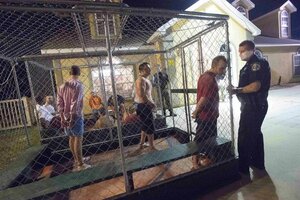Spring Break crackdown: Has the college ritual really gotten worse?
Hundreds of arrests and concerns about photos of a naked, under-age spring breaker undergird concerns in Florida that Spring Break is getting out of hand. But even as the ritual evolves, at its core it remains much the same.

People are taken into custody at the Bay County Sheriff's Office mobile booking unit during spring break festivities in Panama City Beach, Florida. Vans then transport the people to the main jail.
Michael Spooneybarger/REUTERS
ATLANTA
It may be the ultimate love-hate relationship: the annual spring migration of hordes of college-aged Spring Breakers into sunny Florida versus conservative beach towns that relish the cash flow but squirm at the debauchery of unleashed youth.
While other Florida beach towns have basically banned the spring break ruckus, Panama City Beach this year is taking a strict yet nuanced view of the estimated 300,000 revelers flocking southward as the dogwoods prepare to bloom. Already, the county sheriff's department has arrested over 500 people and processed them in open-air jail cells. And given the legality of alcohol on the beach proper, the debauchery is on the national front burner, largely thanks to the work of Fox News, whose Sean Hannity has complained about America’s seeming acceptance of loose morals and alcohol over-indulgence.
Police attention on a social media beach photo of an undressed 17-year-old standing in a group of men have highlighted the concerns in recent days. On Saturday, the girl contacted authorities to assure them that she was safe and that the activity was consensual.
“When you get this many people together being rowdy, it shows our community in a bad light,” Bay County Commissioner Mike Thomas told the AP.
Yet the town, which city officials claim has more churches than bars, has balked at banning the festivities entirely, thanks mostly to the $1 billion the fest pumps into the local mom-and-pop economy every spring.
Instead, officials, starting this year, forced bars to close two hours earlier than last year, mandated valid IDs to quaff on the beach, and banned a spring time practice of digging massive holes in the beach sand in order to engage in illicit behaviors.
Despite the vivid imagery, there’s not a lot of hard evidence that Spring Break has changed dramatically from, say, the 1980s. After all, Ft. Lauderdale in 1985 stopped allowing beach-drinking after incidents of alcohol abuse and nudity sailed to new heights. Today, Daytona Beach, which rose to prominence as host of various MTV spring break bashes, mostly tries to attract families and spring breakers looking for quieter digs.
“Starting in the ‘80s and peaking in the ‘90s, MTV’s programming took the seediest, rawest parts of the college spring break fantasy, cranked up the nudity, told parents to stay … home, threw in some pop stars and pointed cameras at it all,” writes Leslie Horn, on Deadspin.
Given that early confluence of fantasy and cameras, there are decidedly technological and sociological factors that may be ratcheting up the appearance of rock-and-roll antics. A generation drawn to internet fame and social networks set up to feed egos are at the very least giving Americans a more personal view of what really happens at spring break. That means that what happens in Florida often doesn’t stay in Florida.
“Reputations, whether good or bad, are still seen as just that, a reputation,” Brad Milner writes in the Panama City News Herald. “If people are talking about you, if you are on other’s lips, it’s all that matters. Dealing with consequences can come later or not at all.”
Certainly, running off hardcore revelers altogether may seem like a risky idea given the cash flow that Spring Break generates.
But officials in Spring Break-averse towns like Daytona Beach say that appealing to college students is already a risky economic development endeavor, given a “herd mentality” that can quickly move on to the next host beach, where their money, at least for a little while, is welcome.

